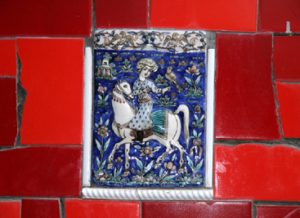The convent’s staircase
It is difficult to find in Rio anyone who knows the Convent’s Traircase, but if you ask for Selarón’s Staircase, someone will soon point out the construction of 215 steps that connect Lapa to Santa Teresa.
On a lucky day, it is possible to find, sitting on a step or at the window of his little room at number 24 by the staircase, the man behind the name: Jorge Selarón, the 59 year old Chilean painter and sculptor who, two decades ago, adopted the staircase to transform it into a gigantic mosaic of more than two thousand tiles in the colors of the Brazilian flag.
With a leafy mustache and a penetrating look, Selarón embodies the epithet he coined to describe his masterpiece: “The great madness”.

Liechtenstein tiles
To complete the work, Selarón counts on the help of tourists who visit the staircase. “I always ask you to send tiles when you get home. Most promise, but do not deliver ”. On trips, he hunts for rarities, like an old Persian tile purchased in New York in December for $ 2,000 (photo).
Proud, he points out some of the 82 countries represented in the work: Afghanistan, Luxembourg, Liechtenstein.
The staircase became a postcard of Rio and was once the scene of U2 and Snoop Dogg clips and even a rehearsal of the American Playboy, remembered by Selarón with a dreamy smile.
In 2005, she was listed by the city hall, which granted the Chilean the title of Honorary Citizen.

Forgive the pattern
Selarón left Chile at 17 and wandered through 57 countries in Asia, Europe and the Americas before arriving in Rio in 1983.
He settled in Lapa more than 15 years ago and never left. On one of the tiles, he thanks in Portuguese the sympathy and understanding of the landlady, Mrs. Elena:
“I want to apologize for the past few years. Since I started decorating the staircase, I have been unable to keep up with my rent”.
Today, he supports himself by selling, for R $ 30 reais each, the paintings he produces on an industrial scale: “I paint five or six a day”.
Selaron spends all h money and time at work. He lives alone, devoted to the staircase: “Marriage takes away freedom, son is a concern. If I had a family, my life would be different ”.
He says the work will only be completed on the day he dies.

Do you know the bearded man?
Selarón started decorating the staircase in 1990, gluing colored tiles on the flowerbeds. He had no plans or ambitions. “Nobody came to see my work, only the flies. But beauty was enough for me ”. Time brought fame, tourists and distinguished visitors. In early 2005, he recognized a gray-haired man who admired the staircase.
“I asked if he was a government authority. He said: ‘I’m on vacation. Today I’m just José Dirceu ‘”. Months before being impeached for corruption, the second most powerful man in the Lula Government was floating around in Lapa.
“He said he liked it here because he was not recognized.” Selarón showed Dirceu a tile with a figure that resembled President Lula.
“He laughed and said he really did. But it’s not Lula, he’s just a bearded man with a hat ”.

Picasso, Gaudí, Selarón
The fame awakened in Selarón a supreme vanity: “Just by looking at the staircase you know that you are facing a great artist”.
Observing visitors, he is able from afar to distinguish mere tourist from a professional photographer. Selarón keeps all praising articles in a large folder.
He is very proud of one in particular: a National Geographic report that consecrates the staircase as “the largest sculpture in the world made by a single individual”.
When talking about his own work, he puts himself in the same crowd as Michelangelo, Picasso, Gaudí – and always ahead of these luminaries: “Barcelona is an ugly city and Gaudí is inferior to me in tiles. He is only superior in the Sagrada Familia. But I don’t make churches ”.

Pregnant self portrait
The figure of a pregnant black woman insinuates itself on all the canvases and tiles displayed on the staircase. Selarón says he has painted the image more than 25,000 times and is able to scribble it in less than two minutes.
In recent years, the pregnant woman has ceased to be a peripheral character in paintings on Rio’s streets and favelas to become the protagonist of the paintings.
The canvases for sale on the facade of his house are variations on the same theme: pregnant woman holds a fish; pregnant goes up the hill.
In three pictures, she has an amputated leg. At the foot of the stairs, a circular mosaic depicts the woman’s body with Selarón’s head: “I painted the pregnant woman so many times that I ended up getting pregnant too”.

A personal problem
The pregnant woman’s ubiquity on the staircase is disturbing. Selarón has a prompt answer for those who investigate the obsession: “It’s a personal problem”, he repeats, laconically, whenever inquired.
He remembers the exact day he started painting the image, March 12, 1977, but won’t explain why.
When pressed, his voice becomes shaky, his eyes flee, his hands search and squeeze a painting of the pregnant woman, until he finally gives in: “Of course it was my wife, of course I was expecting a child of mine”. Was the child born? “It is a personal problem”.
